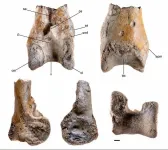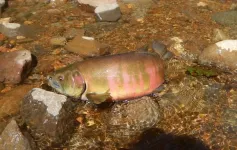(Press-News.org) **EMBARGOED UNTIL RELEASE MONDAY, NOV. 4, AT 1 A.M. ET**
Researchers including a Johns Hopkins University evolutionary biologist report they have analyzed a fossil of an extinct giant meat-eating bird — which they say could be the largest known member of its kind — providing new information about animal life in northern South America millions of years ago.
The evidence lies in the leg bone of the terror bird described in new paper published Nov. 4 in Palaeontology. The study was led by Federico J. Degrange, a terror bird specialist, and included Siobhán Cooke, Ph.D., associate professor of functional anatomy and evolution at the Johns Hopkins University School of Medicine. The bone, found in the fossil-rich Tatacoa Desert in Colombia, which sits at the northern tip of South America, is believed to be the northernmost evidence of the bird in South America thus far.
The size of the bone also indicates that this terror bird may be the largest known member of the species identified to date, approximately 5%–20% larger than known Phorusrhacids, Cooke says. Previously discovered fossils indicate that terror bird species ranged in size from 3 feet to 9 feet tall.
“Terror birds lived on the ground, had limbs adapted for running, and mostly ate other animals,” Cooke says.
The bird’s leg bone was found by Cesar Augusto Perdomo, curator of the Museo La Tormenta, nearly 20 years ago, but was not recognized as a terror bird until 2023. In January 2024, researchers created a three-dimensional virtual model of the specimen using a portable scanner from Johns Hopkins Medicine, allowing them to analyze it further.
The fossil, the end of a left tibiotarsus, a lower leg bone in birds equivalent to that of a human tibia or shin bone, dates back to the Miocene epoch around 12 million years ago. The bone, with deep pits unique to the legs of all Phorusrhacids, is also marked with probable teeth marks of an extinct caiman — Purussaurus — a species that is thought to have been up to 30 feet long, Cooke says.
“We suspect that the terror bird would have died as a result of its injuries given the size of crocodilians 12 million years ago,” she says.
Most terror bird fossils have been identified in the southern part of South America, including Argentina and Uruguay.
The Phorusrhacid fossil discovery as far north as Colombia suggests that it was an important part of predatory wildlife in the region. Importantly, this fossil helps the researchers better understand the animals living in the region 12 million years ago. Now a desert, scientists believe this region was once an environment full of meandering rivers. This giant bird lived among primates, hoofed mammals, giant ground sloths and armadillo relatives, glyptodonts, that were the size of cars. Today, the seriema, a long-legged bird native to South America that stands up to 3-feet-tall, is thought to be a modern relative of Phorusrhacid.
“It’s a different kind of ecosystem than we see today or in other parts of the world during a period before South and North America were connected,” Cooke says
Believed to be the first of its kind from the site, the fossil indicates that the species would have been relatively uncommon among the animals there 12 million years ago, Cooke says.
“It’s possible there are fossils in existing collections that haven’t been recognized yet as terror birds because the bones are less diagnostic than the lower leg bone we found,” she says.
For Cooke, the finding helps her imagine an environment one can no longer find in nature.
“It would have been a fascinating place to walk around and see all of these now extinct animals,” she says.
In addition to Cooke and Perdomo, the study’s authors include first author Federico Javier Degrange of Centro de Investigaciones en Ciencias de la Tierra; Luis G. Ortiz-Pabon of Universidad de Los Andes, Carrera, Bogotá, Colombia and Universidad Nacional de Colombia, Carrera, Bogotá; Jonathan Pelegrin of Universidad del Valle, Colombia, and Universidad Santiago de Cali, Colombia; Rodolfo Salas-Gismondi of Universidad Nacional Mayor de San Marcos, Avenida Arenales, Perú; and Andrés Link of Universidad de Los Andes, Carrera Bogotá, Colombia.
DOI: doi.org/10.1002/spp2.1601
END
Fossil of huge terror bird offers new information about wildlife in South America 12 million years ago
2024-11-04
ELSE PRESS RELEASES FROM THIS DATE:
Scientists create a world-first 3D cell model to help develop treatments for devastating lip injuries
2024-11-04
We use our lips to talk, eat, drink, and breathe; they signal our emotions, health, and aesthetic beauty. It takes a complex structure to perform so many roles, so lip problems can be hard to repair effectively. Basic research is essential to improving these treatments, but until now, models using lip cells — which perform differently to other skin cells — have not been available. In a new study published in Frontiers in Cell and Developmental Biology, scientists report the successful immortalization of donated lip cells, ...
One-third of patients with cancer visit EDs in months before diagnosis
2024-11-04
About 1 in 3 patients diagnosed with cancer in Ontario visited an emergency department (ED) in the 90 days before diagnosis, found a new study published in CMAJ (Canadian Medical Association Journal) https://www.cmaj.ca/lookup/doi/10.1503/cmaj.240952.
In a study that included more than 650 000 patients diagnosed with cancer between 2014 and 2021 in Ontario, 35% (229 683) had visited an ED in the 90 days before diagnosis. Among patients with ED visits before their cancer diagnosis, 64% had visited once, 23% had visited twice and 13% had 3 or more visits. ...
Adolescent exam anxiety can be intensified by pressure to achieve, says academic
2024-11-04
Former teacher Professor of Education David Putwain says ‘heavy-handed’ messages around test results can fuel extreme worry among some 16 to 18-year-olds, even when others respond well to such messages.
Putwain identifies several risk factors, for example students with certain personality traits, including those who are highly self-critical, can underachieve because of severe anxiety in exams. Certain demographics also report higher exam anxiety, including female persons and those from economically deprived backgrounds.
‘Temperature checks’ to identify at-risk ...
A digital health behavior intervention to prevent childhood obesity
2024-11-03
About The Study: A health literacy-informed digital intervention improved child weight-for-length trajectory across the first 24 months of life and reduced childhood obesity at 24 months. The intervention was effective in a racially and ethnically diverse population that included groups at elevated risk for childhood obesity.
Corresponding Author: To contact the corresponding author, William J. Heerman, MD, MPH, email Bill.Heerman@vumc.org.
To access the embargoed study: Visit our For The Media website at this link https://media.jamanetwork.com/
(doi:10.1001/jama.2024.22362)
Editor’s ...
Preventing obesity in very young children could be in the palm of parents’ hands
2024-11-03
A study co-led by a Johns Hopkins Children’s Center clinician-researcher shows that adding text messaging and other electronic feedback to traditional in-clinic health counseling for parents about feeding habits, playtime and exercise prevents very young children from developing obesity and potentially lifelong obesity-related problems.
Findings from the study, which was co-led by Eliana Perrin, M.D., M.P.H., Bloomberg Distinguished Professor of Primary Care at the Johns Hopkins University Schools of Medicine, Nursing and Public Health, will be published in JAMA and presented at the Obesity Society’s “Obesity Week” in San Antonio, both on Nov. ...
Mathematical model illuminates how environment impacts life choices of salmon
2024-11-02
Tokyo, Japan – Researchers from Tokyo Metropolitan University have created a mathematical model that models how the evolutionary strategies of organisms are affected by the environment. They studied salmonid fishes which choose either to migrate to the sea then return to lay eggs or stay in the river depending on their individual features. Their model correctly predicts how the proportion choosing to migrate changes with environmental conditions, predicting how environmental change can trigger eco-evolutionary responses.
Salmonids (or salmon-like) fish are known to face a tough choice early in their lives. They can either stay where they are ...
Houston Methodist researchers shed light on increased rates of severe human infections caused by Streptococcus subspecies
2024-11-01
HOUSTON-(Nov. 1, 2024) – A concerning increase in global rates of severe invasive infections becoming resistant to key antibiotics has a team of infectious disease researchers at the Houston Methodist Research Institute studying a recently emerged strain of bacteria called Streptococcus dysgalactiae subspecies equisimilis (SDSE). SDSE infects humans via the skin, throat, gastrointestinal tract and female genital tract to cause infections ranging in severity from strep throat (pharyngitis) to necrotizing fasciitis (flesh-eating disease).
Closely related to group A streptococcus (also commonly known as Streptococcus pyogenes), which has been very well studied, ...
Auburn University hosts 62nd Hands-On Workshop on Computational Biophysics, featuring the new VMD 2.0
2024-11-01
AUBURN, Ala. – The NIH Center for Macromolecular Modeling and Visualization and Auburn University are pleased to announce the 62nd Hands-On Workshop on Computational Biophysics, taking place from December 16-20, 2024, at Auburn University’s Department of Physics. This prestigious workshop series, first launched in June 2003 by the Theoretical and Computational Biophysics Group at the University of Illinois at Urbana-Champaign, has become a premier global training event in molecular modeling. Supported by NIH, the workshop provides a unique platform for researchers across disciplines to master the latest computational biophysics techniques.
This year’s ...
The Salton Sea — an area rich with lithium — is a hot spot for child respiratory issues
2024-11-01
Windblown dust from the shrinking Salton Sea harms the respiratory health of children living nearby, triggering asthma, coughing, wheezing and disrupted sleep, USC research shows.
The findings also indicate that children living closest to the sea, who are exposed to more dust in the air, may be the most affected.
The study, published in Environmental Research, found that 24% of children in the area have asthma — which is far higher than the national rate of 8.4% for boys and 5.5% for girls. The abnormally high rate raises health experts’ concerns about the children’s health in this predominantly low-income community of color 150 miles southeast of Los Angeles.
Furthermore, ...
University of Maryland-YouGov poll: Alsobrooks dominates Hogan, amendment to state constitution garners broad support
2024-11-01
With only days to go in the 2024 general election, the Applied Political Analytics Program (APAN) at the University of Maryland, in partnership with the public opinion firm YouGov, released today the results from an Oct. 23-27, 2024 poll of 500 likely Maryland voters that finds broad support for reproductive freedom, and Angela Alsobrooks (D) with a sizeable lead over former Maryland governor Larry Hogan (R) in the race to fill a U.S. Senate seat.
The poll found that across the state, Kamala Harris (D, 60.9%) holds a 27 percentage-point lead over Donald Trump (R, 33.9%). The data also show Angela Alsobrooks (D, 57.4%) with a ballooning 23 percentage-point ...



